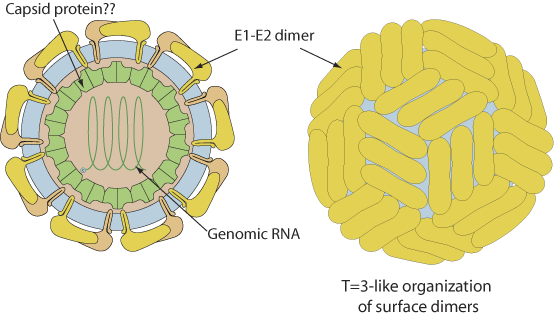VIRION

Enveloped, spherical, about 50 nm in diameter.
GENOME
Monopartite, linear, ssRNA(+) genome of about 10 kb. There is an internal ribosome entry site (IRES) at the 5' end that mediates translation initiation. The genome does not appear to encode a capsid (or core) protein. The virions, however, have a nucleocapsid. It is not clear if an additional capsid protein might arise from cleavage of the N-terminus or from an alternative reading frame.
GENE EXPRESSION
The virion RNA is infectious and serves as both the genome and the viral messenger RNA. The whole genome is translated in a polyprotein, which is processed co- and post-translationally by host and viral proteases.
ENZYMES
- RNA-dependent RNA polymerase [NS5]
- FAD capping? [NS5]
- Polyprotein major protease (Peptidase S29) [NS3]
- Self-cleavage N-ter polyprotein (Peptidase C18) [NS2]
REPLICATION
- Attachement of the viral envelope protein E to host receptors mediates internalization into the host cell by clathrin-mediated endocytosis.
- Fusion of virus membrane with host endosomal membrane. RNA genome is released into the cytoplasm.
- The positive-sense genomic ssRNA is translated into a polyprotein, which is cleaved into all structural and non structural proteins (to yield the replication proteins).
- Replication takes place at the surface of endoplasmic reticulum in cytoplasmic viral factories. A dsRNA genome is synthesized from the genomic ssRNA(+). Host miRNA mir-122 plays a essential role in initiating replication.
- The dsRNA genome is transcribed/replicated thereby providing viral mRNAs/new ssRNA(+) genomes.
- Virus assembly occurs at the endoplasmic reticulum. The virion probably buds at the endoplasmic reticulum, is transported to the Golgi apparatus.
- Release of new virions by exocytosis.

